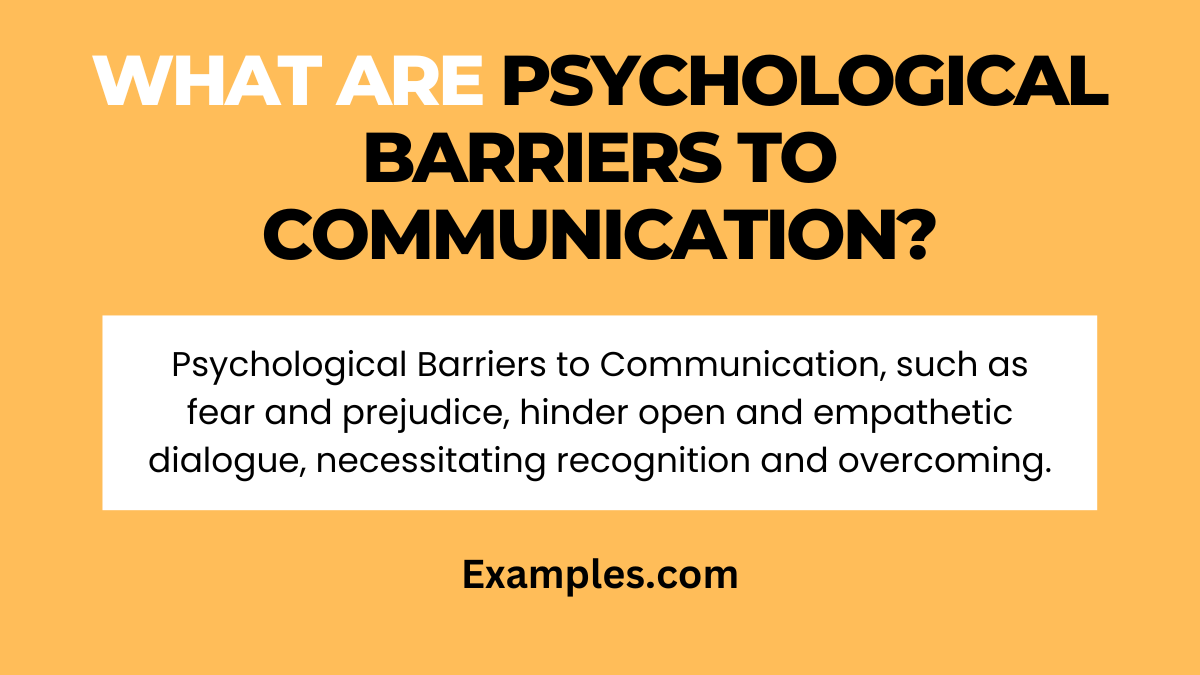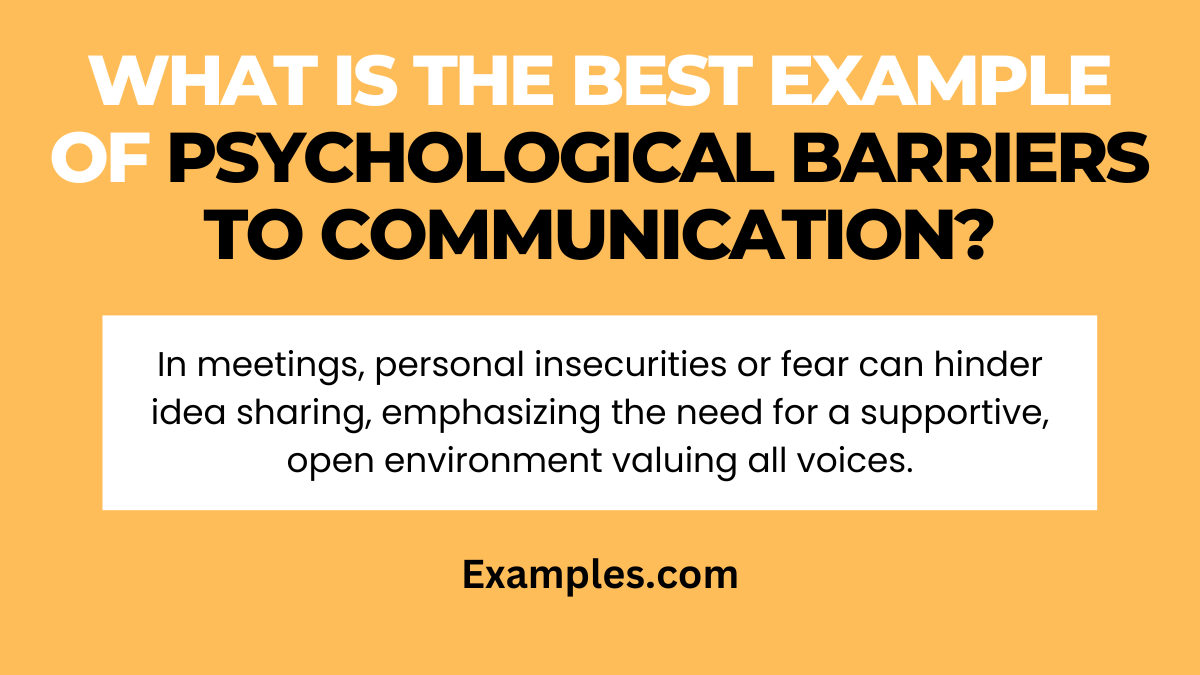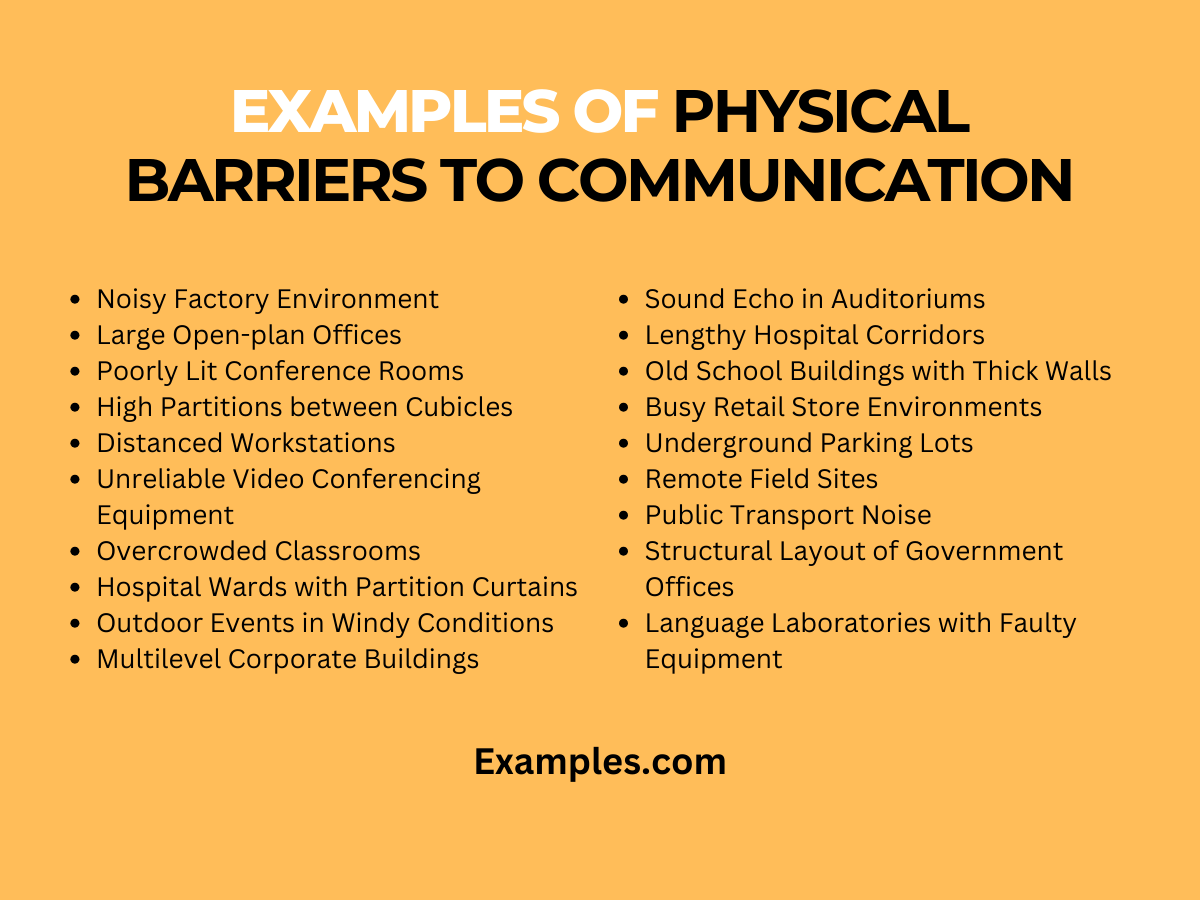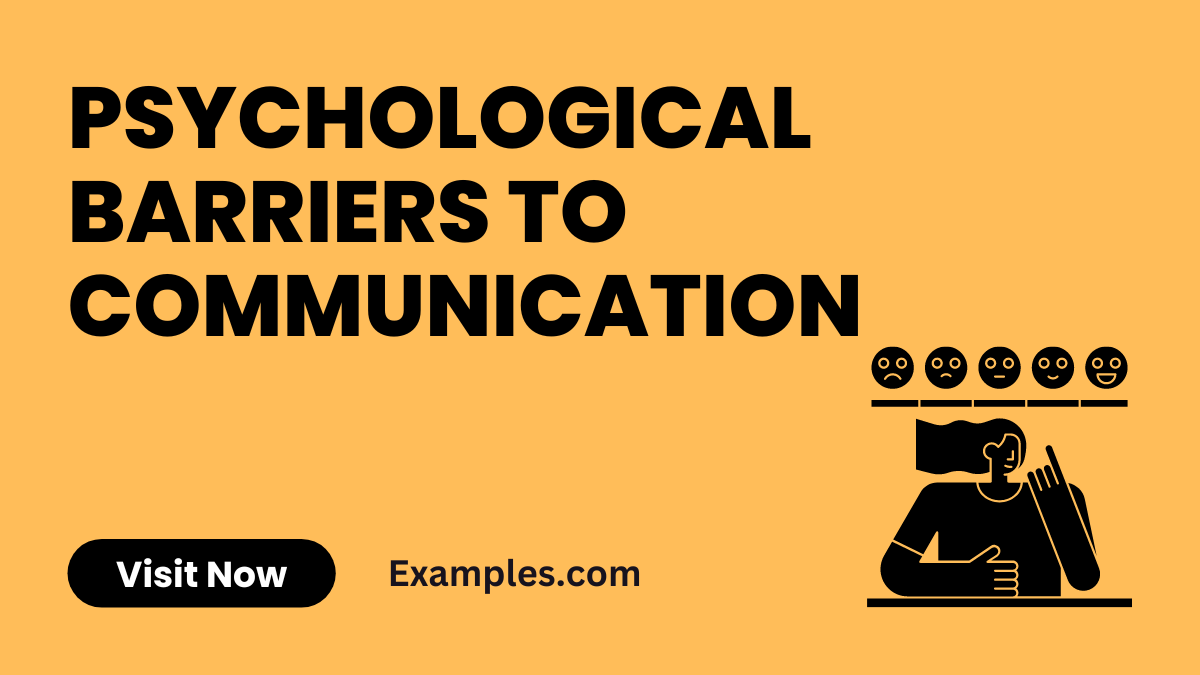19+ Psychological barriers to Communication Examples
Psychological Barriers to Communication refer to internal obstacles that can hinder the process of sharing and receiving information. These barriers, rooted in our perceptions, attitudes, and emotions, significantly impact the effectiveness of communication. This guide delves into various psychological barriers, such as anxiety, bias, and lack of confidence, that can impede clear and open dialogue. Understanding and addressing these barriers is vital for fostering effective communication in both personal and professional contexts.
What are Psychological Barriers to Communication?

Psychological Barriers to Communication encompass mental and emotional factors that impede the flow of information between individuals. These barriers include fear, mistrust, prejudice, and emotional distress, which can prevent open and honest dialogue. Recognizing these internal obstacles is crucial for effective communication, as they can distort perception and hinder the ability to convey or interpret messages accurately. Understanding and overcoming these barriers is essential for clear, empathetic, and constructive communication.
What is the Best Example of Psychological Barriers to Communication?

A typical example of Psychological Barriers to Communication is when personal insecurities or fear of judgment lead to withholding important thoughts in a team meeting. This barrier prevents the open sharing of ideas and can hinder collective problem-solving. Addressing such psychological hurdles involves building a supportive environment that encourages openness, understanding, and mutual respect, thereby ensuring that all voices are heard and valued in the communication process.
20 Examples of Physical Barriers to Communication

Physical Barriers to Communication are tangible impediments that can significantly affect the clarity and effectiveness of interactions. From structural elements to technological hindrances, these barriers can disrupt the flow of information in various environments, such as workplaces, educational settings, and public spaces. Identifying and addressing these barriers is essential for facilitating smooth and effective communication. This section explores 20 distinct physical barriers and illustrates how they manifest in everyday situations, providing insight into overcoming these challenges for enhanced communication.
- Noise in Industrial Workplaces: Loud machinery can drown out conversations, necessitating alternative communication methods.
“We use visual signals and text messages for communication in the noisy factory.” - Open Office Layouts: Lack of privacy and constant distractions can impede focused conversations.
“We use meeting rooms for confidential discussions in our open-plan office.” - Poor Acoustics in Auditoriums: Echoes and sound distortion make it hard to understand speakers.
“Installing acoustic panels improved speech clarity in our auditorium.” - Large Physical Distance Between Departments: Separation by floors or buildings can delay information sharing.
“We use a centralized communication system to connect different departments effectively.” - Unreliable Internet in Remote Locations: Weak connectivity hampers virtual meetings and digital communication.
“For remote sites, we have satellite internet backups to ensure continuous connectivity.” - Cramped Retail Spaces: Overcrowded areas make it difficult for staff to communicate with customers.
“Our staff use headsets to communicate over the crowd noise in the store.” - Dilapidated School Buildings: Old structures with poor layout hinder student-teacher interaction.
“Renovating the old classrooms enhanced the communication flow between students and teachers.” - Wall Partitions in Offices: Barriers that obstruct view and hinder spontaneous discussions.
“We introduced glass partitions for better visibility and easier communication.” - Visual Obstructions in Public Speaking: Objects blocking the audience’s view can limit engagement.
“I ensure the stage is clear of obstructions for an unimpeded view during presentations.” - Inadequate Sound Equipment in Events: Poor quality microphones and speakers lead to poor audibility.
“Upgrading our sound system ensured clear communication during large events.” - Physical Barriers in Classrooms: Fixed seating and podiums restrict teacher-student interaction.
“Rearranging classroom furniture facilitated more interactive communication.” - Intensive Care Units in Hospitals: Glass partitions and equipment noise make communication with patients challenging.
“We use intercoms for clearer communication with patients in ICU.” - Long Corridors in Hotels: Difficulty in communicating across distant areas in large hotels.
“Staff use walkie-talkies for quick communication across the hotel.” - Dim Lighting in Conference Rooms: Inability to see facial expressions and non-verbal cues.
“Enhanced lighting in our conference rooms improved non-verbal communication.” - Rural Areas with Limited Technology: Lack of modern communication tools affects information dissemination.
“We set up community centers with internet access in rural areas for better communication.” - Distractions in Home Offices: Home environment noises and interruptions can impact virtual meetings.
“Using noise-cancelling headphones helps me focus during online meetings from home.” - Busy Urban Streets: Ambient noise makes verbal communication on streets difficult.
“In noisy urban areas, I prefer texting to phone calls for clearer communication.” - Layout of Government Buildings: Complex layouts make finding specific offices or personnel challenging.
“Clear signage and directory maps in government buildings aid in better navigation and communication.” - Limited Access Areas in Construction Sites: Restricted entry zones hinder communication among construction workers.
“We use walkie-talkies to communicate across different zones on the construction site.” - Transportation Noise in Airports: Announcements and aircraft noise can impede clear communication.
“Airports use visual displays alongside announcements to ensure messages are conveyed clearly despite the noise.”
These examples highlight the diverse nature of Physical Barriers to Communication and emphasize the importance of implementing effective strategies to overcome these challenges, ensuring effective and efficient information exchange.
What are Some Common Psychological Barriers to Communication
Psychological barriers in communication stem from personal internal factors that can hinder the exchange of ideas and feelings. Recognizing these barriers is the first step toward effective communication.
- Anxiety and Stress: High stress levels can cloud judgment and impede clear thinking.
- Prejudices and Stereotypes: Preconceived notions about others can skew perception and interaction.
- Lack of Confidence: Insecurity may lead to hesitation in expressing thoughts.
- Emotional Instability: Strong emotions like anger or sadness can distort communication.
- Defensiveness: Being overly defensive prevents open and honest dialogue.
- Misinterpretation of Non-Verbal Cues: Misreading body language or tone can lead to misunderstandings.
- Overthinking: Over-analyzing situations can complicate simple communication.
- Close-Mindedness: Unwillingness to consider others’ viewpoints.
- Selective Perception: Focusing only on aspects that reinforce one’s beliefs.
- Mental Health Issues: Conditions like depression or anxiety disorders can impede communication.
Understanding these barriers helps in identifying and addressing the root causes of communication issues.
What Often Causes Psychological Barriers in Effective Communication
Psychological barriers in communication often stem from personal experiences, beliefs, and emotional responses.
- Past Experiences: Negative past interactions can influence current communication.
- Cultural Differences: Misunderstandings arising from cultural backgrounds.
- Personal Biases: Prejudices affecting perception and interaction.
- Fear of Rejection: Concern about others’ responses can inhibit sharing.
- Low Self-Esteem: Feeling unworthy of being heard or understood.
- Perfectionism: Fear of making mistakes while communicating.
- Power Dynamics: Imbalance in authority affecting openness.
- Lack of Trust: Distrust in others can stifle communication.
- Conflict Avoidance: Avoiding confrontation can lead to withholding information.
- Information Overload: Excessive information leading to confusion and misunderstanding.
Acknowledging these causes is crucial for addressing and improving communication dynamics.
What are the Ways to Overcome Psychological Barriers?
Overcoming psychological barriers in communication requires conscious effort and strategies to ensure effective and open exchanges.
- Active Listening: Focus on truly understanding the speaker’s perspective.
- Building Trust: Establish a trusting environment for open communication.
- Empathy: Show understanding and consideration for others’ feelings.
- Self-awareness: Recognize and understand one’s own emotional state.
- Stress Management: Develop techniques to handle stress effectively.
- Seeking Feedback: Encourage others to provide honest feedback.
- Mindfulness Practices: Stay present and focused in conversations.
- Therapeutic Intervention: Seek professional help when needed.
- Assertiveness Training: Learn to express oneself clearly and respectfully.
- Cognitive Restructuring: Change negative thought patterns affecting communication.
Implementing these strategies can significantly improve one’s ability to communicate effectively.
Psychological barriers present significant challenges to effective communication. This guide has explored common barriers, their causes, and strategies to overcome them, emphasizing the importance of self-awareness, empathy, and active listening. By addressing these barriers, individuals can enhance their communication skills, leading to more meaningful and productive interactions in both personal and professional contexts. Understanding and overcoming psychological barriers is key to fostering open, honest, and effective communication.



